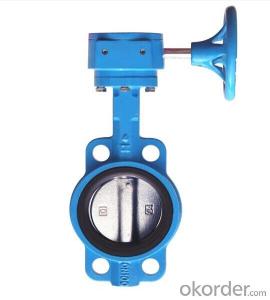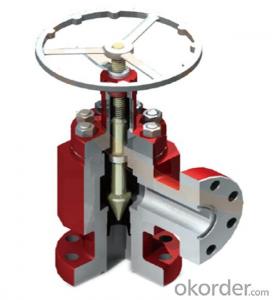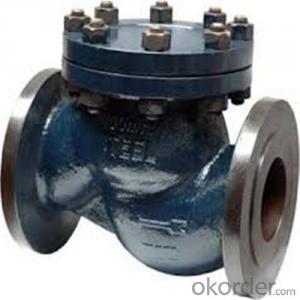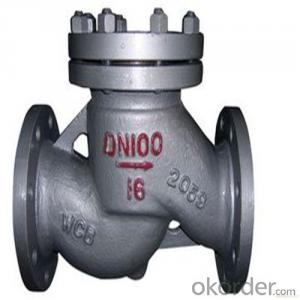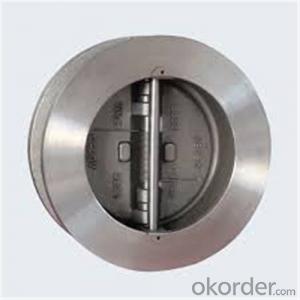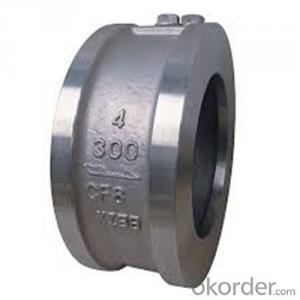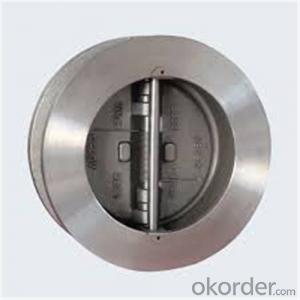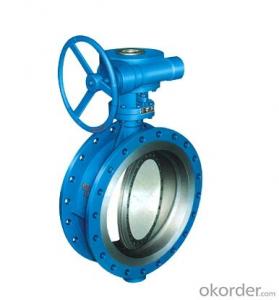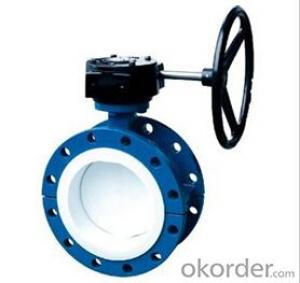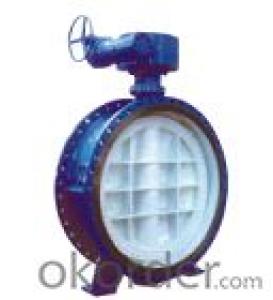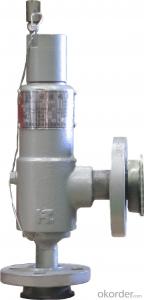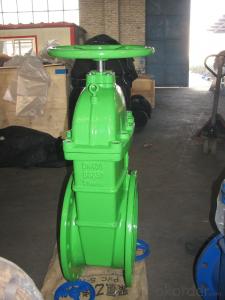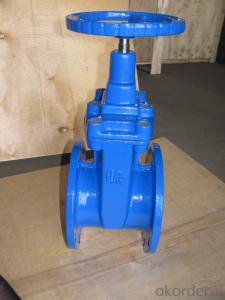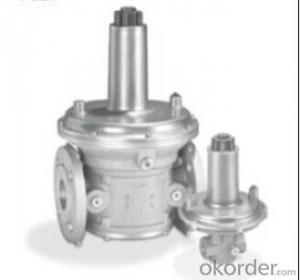Turbine Type Butterfly Valve DN450 with Hand Wheel BS Standard
- Loading Port:
- China main port
- Payment Terms:
- TT OR LC
- Min Order Qty:
- 100 set
- Supply Capability:
- 50000 set/month
OKorder Service Pledge
OKorder Financial Service
You Might Also Like
1. Manual Wafer Butterfly Valve Description:
A butterfly valve is a valve which can be used for isolating or regulating flow. The closing mechanism takes the form of a disk. Operation is similar to that of a ball valve, which allows for quick shut off. Butterfly valves are generally favored because they are lower in cost to other valve designs as well as being lighter in weight, meaning less support is required.
2.Main Features of the Manual Wafer Butterfly Valve
1. Small in size and light in weight, easy instillation and maintenance. It can be mounted wherever needed
2. Simple and compact construction, quick 90 degrees on-off operation
3. Minimized operating torque, energy saving
4. Flow curve teeing to straight line, excellent regulation performance
5. Long service life, standing the test of tens of thousands opening/closing operations
6. Bubbles-tight sealing with no leakage under the pressure test
3. Manual Wafer Butterfly Valve Images: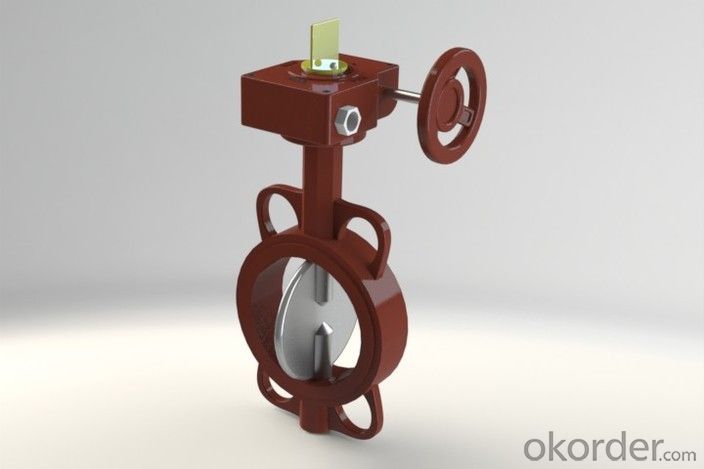
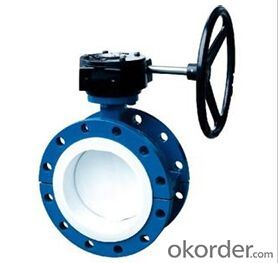
4.Manual Wafer Butterfly Valve Specification:
Size: DN50-DN1000
End flange: ANSI B 16.1,EN1092,AS2129
Face to face: ANSI B 16.10
Top flange: ISO 5211
Normal pressure: PN1.0/1.6MPa(150/200PSI)
Body: CI/DI/WCB/ALB/CF8/CF8M
Disc: DI/ALB/Rubber lined Disc/1.2501/1.4529/CF8/Hastelloy Alloy/Monel
Stem: 410/416/304/431/17-4PH/316/monel
Seat: NBR/Hypalon/EPDM/Neoprene/NR/Wear-Resistant EPDM/Viton/Silicon/Heat-Resistant EPDM/White 5.FAQ
1. What is manual wafer butterfly valve?
A: Wafer style is the more common of the two and is less expensive than the lug style. The wafer style butterfly valve is just about the standard. It ís so common that no one even bothers to use the word "wafer" when ordering a butterfly valve. It is taken for granted that if a butterfly valve is ordered, a wafer style will be received.
2. What is the working principle of manual wafer butterfly valve?
A: A butterfly valve is from a family of valves called quarter-turn valves. In operation, the valve is fully open or closed when the disc is rotated a quarter turn. The "butterfly" is a metal disc mounted on a rod. When the valve is closed, the disc is turned so that it completely blocks off the passageway.
- Q: what is the difference between mitral valve prolapes and mitral regurgitation?
- Your okorder /
- Q: 1990 Pontiac Sunbird 2.0L Fuel Injected has EGR Valve, I can suck and blow through the hose connected to it, an I supposed to be able to do this, or not...? It looks old, like it's been on the car forever...
- It recirculates the fumes and the air--but a cracked hose is a nightmare if vacuum leak develops--fix it--just get a new hose and happy motoring
- Q: i have a zone that - when turnd on by timer or manually only about 1 foot of spray comes out of sprinkler heads (used to wk fine). When i turn the ittle screw on top of valve (its about the size of a dime) water pressure comes up and wks fine - only water leaks at screw and when zone comes on next time NO pressure??? metal valves were just replaces about 1 yr ago.
- It's hard to say exactly what's wrong without knowing what type of valves you have since different valves have different components. In any case, I'd start by checking that the bleed screw and/or handle (depending on type) and that the flow control screw or handle (again depends on what make/model you have) to make sure they are in good condition and properly set. Be careful when turning these screws or handles don't force them past the normal stopping points. If that all checks out, there may be some dirt or debris stuck in the valve that's not allowing the diaphragm to open all the way.
- Q: I think I have a bad valve steam seals because when I start the car white-grayish smoke comes out of the back of the car. When let sit for 2 or more hours start car and smoke comes out everytime. Will a valve adjusment fix the problem? Thanks
- Don't okorder
- Q: im 16 and im rly scared i have already been checked out by the hospital and they sed that i have a moderately leaky heart valve. They recommended me to see a childrens cardiologist since they dont specialize in children. i have to get another echo and some other tests done i think. im so nervous. whats going to happen to me??
- dont mind buddah ,youl be fine 1 in 5 people have it and never know but you can live a worry free full life just like anyone else as long as you look after yourself
- Q: are the carborator reed valves supposed to be open or closed on a 1999 yz 250?dirt bike
- reed valves depend on engine vacuum to operate. the reed valves are closed when the engine is off and as the engine load goes up, it requires more fuel so engine vacuum goes up causing the reed valves to open more, letting in more fuel. So, is the engine running or off?. are the reeds bent? if they are, they might be straightened if u use care. they break ez.
- Q: I have a lawn tractor with a 10 hp Tecumseh and its running so rich because of the carburetor float valve not seating. So how should I fix this?
- www.okorder
- Q: This is my first tranny install and there is one thing that i really think i f'd up on. I'v been installing a junk yard 700r4 and transfer case into this beater 1990 k1500. Everything is in i'm just waiting on a new throttle valve cable (detent cable) to put it. But me, being my first tranny install, thought that the piece inside of the transmission that the detent cable attatches too.....came out. which i later found out that it doesn't, and that the TV cable just connects to it. I yanked on it pretty good with some pliers, and it never came out, and it still moves up and down. My question is could i have done some serious damage to that peice and the throttle valve itself???? let me know what u think.... thanks!
- The only thing i can think you could have done i bent the peice that comes out of the trans. If the throttle valve still returns like a spring when you pull it with your fingers and you can still hook the tv cable to it it should be fine. unhook the tv cable at the carb or throttle body to hook it to the valve then hook it back to the carb or throttle body.
- Q: I am looking at buying a 2001 Pontiac Bonneville and the guy said the car's check engine light says it had a problem with the EGR valve and so he bipassed it somehow. He said a EGR valve isn't needed. Is this valve very important or needed? What does it do? Thanks
- I agree with Thumpin8....98%...... Main problem is if you run Unhooked or bypassed and Running rich will cause more problems.... Will burn out your Oxygen sensor next Then fault codes will double up in your ECM PCU programs Then running rich, injectors might over presure at the wrong time. That when your fuel mileage get even worse.... Good Luck.... Pass on the car.... If he says the EGR is out most likely has 3 running problems by now Stating EGR is not needed....
- Q: i have a 1991 rm125 and i want to open the power valves myself can anyone tell me how to do thisTHANKS!
- dude leave the power valves alone. you do not know what you are doing.
Send your message to us
Turbine Type Butterfly Valve DN450 with Hand Wheel BS Standard
- Loading Port:
- China main port
- Payment Terms:
- TT OR LC
- Min Order Qty:
- 100 set
- Supply Capability:
- 50000 set/month
OKorder Service Pledge
OKorder Financial Service
Similar products
Hot products
Hot Searches
Related keywords
